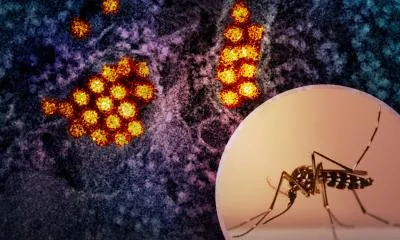
Revolutionary 'Dengue-on-a-Chip' Technology Pioneers a New Era in Fighting the Virus
2025-04-11
Author: Rajesh
A Rising Threat: The Global Spread of Dengue
Dengue fever, a mosquito-borne illness, is emerging as a formidable global health challenge, exacerbated by climate change. Affecting millions, this virus is spreading with alarming speed, and researchers are racing against time to combat this escalating threat.
Introducing the Dengue Model on a Chip
In a groundbreaking breakthrough, scientists at Leiden University, spearheaded by Alireza Mashaghi, have unveiled the world's first 'dengue-on-a-chip' model. This innovative device simulates how the dengue virus interacts with the human body, providing a fresh perspective on the disease’s mechanisms. Mashaghi, realizing the absence of such a model, states, 'We decided to make one.'
Understanding the Deadliest Effects of Dengue
Published in the journal ACS Biomaterials Science & Engineering, this research harnesses organ-on-a-chip technology to recreate the virus’s behavior at a cellular level. The focus is particularly on hemorrhagic shock, a potentially fatal complication that can lead to severe bleeding and organ failure. The findings reveal significant changes in the mechanical properties of endothelial cells, which line blood vessels, during dengue infections. Mashaghi explains, 'This disrupts how blood vessels hold together, causing blood to leak out.'
An Interdisciplinary Approach That Redefines Research
This pivotal research highlights a critical gap in traditional medical and virological studies: the mechanics of disease. By integrating principles from virology, cell biology, and bioengineering, the team aims to enhance drug development, making it faster, cheaper, and ethically more feasible than conventional animal testing. The urgency of this model cannot be overstated, as dengue now threatens over 3.9 billion people across 129 countries. Annually, around 96 million individuals fall ill, with approximately 40,000 fatalities.
Next Steps: Modeling Dengue's Impact on Skin
The research team is not stopping here. They're currently focused on how dengue affects the skin—the first organ the virus attacks post-mosquito bite. 'The skin is heavily influenced by outside temperature,' Mashaghi notes, aiming to explore how variations in heat and humidity impact immune responses. The ultimate objective? Creating a skin-on-a-chip model that can be subjected to diverse climatic conditions to unveil early infection stages and the influence of climate on these processes.
A Call to Arms Against Climate-Driven Viruses
By merging mechanics with virology, this innovative approach could usher in transformative changes in dengue research. 'It’s exciting to see how far we can go by combining disciplines,' Mashaghi concludes. As dengue continues to rise, this pioneering research could be crucial in developing effective treatments and ultimately saving lives.


 Brasil (PT)
Brasil (PT)
 Canada (EN)
Canada (EN)
 Chile (ES)
Chile (ES)
 Česko (CS)
Česko (CS)
 대한민국 (KO)
대한민국 (KO)
 España (ES)
España (ES)
 France (FR)
France (FR)
 Hong Kong (EN)
Hong Kong (EN)
 Italia (IT)
Italia (IT)
 日本 (JA)
日本 (JA)
 Magyarország (HU)
Magyarország (HU)
 Norge (NO)
Norge (NO)
 Polska (PL)
Polska (PL)
 Schweiz (DE)
Schweiz (DE)
 Singapore (EN)
Singapore (EN)
 Sverige (SV)
Sverige (SV)
 Suomi (FI)
Suomi (FI)
 Türkiye (TR)
Türkiye (TR)
 الإمارات العربية المتحدة (AR)
الإمارات العربية المتحدة (AR)